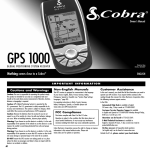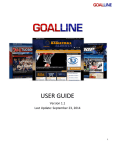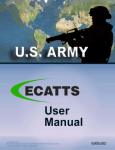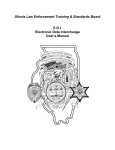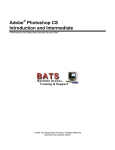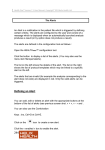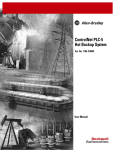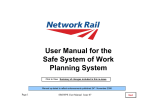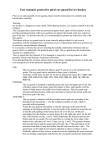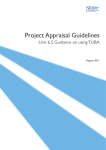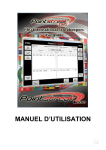Download (Part 3), please click here.
Transcript
Section 1: Introduction Hockey Nova Scotia is pleased to provide all member associations, teams, leagues and clubs with this 2011 - 2012 Clinic Schedule and Registration Guide. Each member has a responsibility to ensure that all new coaches, trainers and instructors receive certification training to assist them in delivering a quality program to the children who play within your respective organization. This guide has been developed to assist you in understanding the certification requirements applicable to your coaches, trainers and instructors as well as to provide you with the information you need to register each with ease. Hockey Nova Scotia would like to thank each you for your support in following the processes set out in this guide and for ensuring that your members receive this important training as they embark on their important role as coach, trainer or instructor. Section 2: Clinic Scheduling All certification clinics held by Hockey Nova Scotia during the season will be scheduled and administered entirely by Hockey Nova Scotia. Hockey Nova Scotia books the facilities, obtains the necessary resources, assigns the Course Facilitator and administers the registration process. The role of the association or club team is to identify your certification requirements and register your coaches, trainers and instructors in the most appropriate clinic. The official Clinic Schedule is found at APPENDIX A of this guide or on the Hockey Nova Scotia website at www.hockeynovascotia.ca under the Development section. Section 3: Selecting a Clinic Clinics are established by geographic region where any individual within that region, regardless of which association, team or club they are from, can register and attend. It is also important to note that if a member of your organization lives outside of the geographic region but, because of timing, would like to attend a specific clinic in another area, they may do so by simply registering in the same manner that they would if the clinic was held locally. By holding regionalized clinics, Hockey Nova Scotia hopes to maximize attendance at clinics by opening them up to registrants from any of the surrounding Associations and Club teams on a first come basis. This also offers flexibility to associations when booking seats in clinics. Section 4: Registering for Clinics The Association Development Coordinator, team or club President, or his/her designate, must register participants for clinics. Coaches are not permitted to register themselves. This is necessary as most associations cover the costs of the clinic registration fees for their coaches and it is critical that they are aware of whom and how many are attending any clinics. Registration is to be carried out by contacting the Clinic Contact identified in the official schedule. The Hockey Nova Scotia office will not accept any clinic registrations. The official clinic registration form is found at APPENDIX B and must be e-mailed to the Clinic Contact using the e-mail address specified in the schedule. Associations, teams and clubs are required to use the official clinic registration form so that all participation data is provided. Failure to use this form creates difficulty in clearly identifying the individual registered and could render his attendance invalid if the proper personal information is not provided. The proper registration is the responsibility of the association, team and/or club. NOTE: Associations who do not use the official clinic registration form may be refused entry into clinics. The cut-off date for registration shown in the official clinic schedule will be in effect for all clinics to enable planning and preparations to proceed. A maximum of 35 participants may be registered for a clinic so register early for your particular clinic to avoid disappointment. After that date, no further registrations will be accepted. For this reason, associations, teams and clubs are requested to register early. Teams and Associations are requested to identify when a participant is being registered for the HSP Re -qualification portion of the Hockey Safety Program. Once a registration has been received, the Clinic Contact will confirm all registrations that are accepted into a clinic by notifying the association or club contact through e-mail on the registration cut-off date or sooner (for early registrants). In the event that a clinic is filled to capacity, the Clinic Contact that will notify the association, team and club who are trying to register their member promptly. Organizations should then review the remaining schedule and register with another upcoming clinic at a future date. Please Note: Participants that arrive for clinics that have not been properly registered will be turned away regardless of how far they have traveled. Associations, teams and clubs must ensure that they do not direct participants who have not been registered to any clinics. Associations and clubs will be charged an administrative fee in any instance where a registered participant fails to show for a clinic. Associations or Clubs are asked to advise all registrants that they will be expected to attend the entire clinic and participate in all activities. Failure to do so will negate their qualification. Associations are expected to register their participants as early as possible to avoid disappointment when clinics fill to capacity. Please be reminded that no clinics will be held after the final clinic date shown on the official schedule and every effort must be made to register members before the final date.. Section 5: Certification Requirements All Coaches, including assistants, at the Atom ‘AAA’, ‘AA’, ‘A’ ‘B’, Peewee ‘AAA’, ‘AA’, ‘A’, ‘B’,’ Bantam ‘AAA’, ‘AA’, ‘A’ ,‘B’,C, Midget Major, ‘AAA’ Minor, ‘AA’, ‘A’, ‘B’, and C’ and Junior ‘A’, ‘B’ and ‘C’ divisions within HNS must be certified at the N.C.C.P. Development Level I Clinic; All instructors at Initiation division (players aged 5 & 6) are to be certified with a minimum Intro Coach Program All coaches at the Novice division (players aged 7 & 8) are to be certified with a minimum Intro Coach Program All coaches at House/Recreational level from Atom, Peewee, Bantam, Midget must certified in the minimum Intro Coach Program or old Initiation Program. NCCP DEVELOPMENT I is acceptable for House / Rec coaches NOTE: Coaches at higher levels who are required to take the NCCP Development Level I clinic will not be permitted to take the Intro Coach clinic. Also, coaches and instructors at the Initiation entry level and Novice levels will not be permitted to register for the NCCP Development Level I clinic. Coaches and instructors must register in the clinic established as appropriate to the age grouping of the players they are coaching/instructing. All bench officials/coaches, including assistants and trainers at the “AAA”, “AA”, and “A” divisions at all levels must be certified in the Hockey Canada Safety Program. This certification must be renewed every three years and coaches are responsible to verify their currency annually. Coaches/Instructors who are required to requalify may do so by registering for any scheduled Hockey Canada Safety Program clinic and attending the afternoon session only. Individuals who attend the afternoon sessions for the purposes of requalification must identify such at registration and are responsible to bring their original Hockey Safety Manuals to the clinic as they will not be supplied. Individuals who register for the fill course will receive manuals at the clinic. All medically trained professionals must take the HSP Course. It deals with rink safety, hockey equipment fitting and various other non first aid topics that are specific to hockey All teams at the “B”, “C”, and Recreational divisions must have at least one member of the bench staff certified in the Hockey Canada Safety Program. Bench staff includes Head Coach, Assistant Coaches and Trainer. (Note: Recreational divisions include the Initiation Program and Novice division All Initiation Program and Novice Teams/ Groupings must have at least one coach or instructor certified in the Hockey Canada Safety Program It is recommended that all teams at the “AAA”, “AA”, and “A” levels have at least one member of the bench staff certified at the HCSP Level II. HCSP Level II is available to individuals who hold a valid First Aid certificate and CPR Level “C” from a recognized agency. HCSP Level II is provided once an individual provides proof of certification. There is no clinic training required for this certification. With this certification, an individual will have to refresh every five (5) years instead of every three (3) years. Individuals interested in obtaining this certification may do so by providing proof of the required qualifications to Hockey Nova Scotia. Contact Hockey Nova Scotia at (902) 4549400 for more information. A new coach (1st year) will only be required to attend a maximum of one (1) certification clinic in any one (1) season. If a coach is new and requires both the NCCP and the HSP, they would take the NCCP Development Level I or Initiation Program clinic (as applicable in year one and the Hockey Safety Program Clinic in their second season. This would allow the coach to be eligible for both seasons.) NOTE: The Hockey Nova Scotia deadline for registration of coaches of all ‘AAA” level teams is October 15th annually. The registration deadline for all remaining REP teams (AA, A, B) coaches is October 31st annually. These dates are in place to afford Hockey Nova Scotia the opportunity to advise associations, teams and clubs early in the season when their respective coaches do not possess the necessary certification and allow them to attend clinics as scheduled. A coach will only be required to attend one (1) certification clinic in any one (1) season. (i.e. if a coach is new and requires both the NCCP and the HSP, they must take the NCCP and be eligible to coach in year one. They would then take the HSP in year two.) Requalification clinics will be held in conjunction with regular Hockey Safety Clinics with the re qualifying participants attending the afternoon session commencing at 12:30 p.m. NOTE: For the NCCP, coaches who have previously certified in either the NCCP Coach or NCCP Intermediate levels are not required to take the new NCCP Development I Level Clinic where that is required. They will be eligible to coach with what they currently have. Coaches with the Initiation Program Coaching Course, do not have to take the Intro Coach Program. Section 6: Definitions: Coach or Assistant Coach A person who is both on the bench during games and is on the ice during practices Trainer A person who is on the bench during the games to attend to any injuries. This person is on the bench or in the rink during practices as well - but does not go on the ice at all to help with any practices Manager A person who volunteers to help out a team with booking ice time, submitting tournament applications and making travel plans, coordinates team budgets and fundraising events. This person does not go on the bench during games and does not go on the ice during practice Section 7: Clinic Overviews Each clinic has it’s own specific curriculum which has been developed by Hockey Canada to best suit the coach and the level in which they are involved. Intro Coach Program: Course Length: Eight (8) hour classroom clinic. Program curriculum: Having fun and engaging in physical activity; Learning the basic skills required to play hockey (skating, puck handling, passing, and shooting); Developing an understanding for basic teamwork through participation in activities; Creating and refining basic motor patterns Introducing children to the basic concepts of fair play and cooperation; Participant Notes: Participants are provided with a course manual and should be prepared to take notes and participate in written exercises. Meals are not provided. National Coaches Certification Program: Course Length: Sixteen (16) hour clinic held over a two-day period. Program curriculum: Coaching Philosophy; Communication; Analyzing Performance; Planning practices; Designing practices Practice and drill management; Seasonal planning: Teaching skills in practice; Participant Notes: Participants are provided with a course manual and should be prepared to take notes and participate in written exercises. Meals are not provided. Participants are encouraged to dress comfortably as the clinic includes inclass activities such as injury prevention. NOTE: Participants must attend all sessions in their entirety to be eligible for certification. Hockey Safety Program: Course Length: Eight (8) hour classroom clinic. Program curriculum: Safety person’s responsibilities; Safety person’s code of ethics; Risk management; Medical history files: Bullying, harassment and abuse; Emergency action plan; Protective equipment; Injury prevention techniques; Injury Management; Return to play; Special Topics. Participant Notes: Participants are provided with a course manual and should be prepared to take notes and participate in written exercises. Meals are not provided. Participants are encouraged to dress comfortably as the clinic includes inclass activities such as injury prevention. NOTE: Hockey Canada mandates that individuals must re-qualify after three years to maintain currency and eligibility within the Hockey Safety Program. This requalification is a four (4) hour clinic. As the content of the clinic manual has changed from past years, participants will be issued a manual at the course. To register for requalification, ensure that this information is provided to the Clinic Contact at the time of registration. Requalification clinics will be held in conjunction with regular Hockey Safety Clinics with the requalifying participants attending the afternoon session commencing at 12:30 p.m. Section 8: Clinic Fees Clinic registration fees will be as follows: Intro Coach Program - $102.60 Hockey Safety Program - $102.60 Hockey Safety Requalification Program - $74.10 National Coaches Certification Program - $136.80 Hockey Nova Scotia will invoice the registering Association or Club team upon conclusion of the clinic. Participants will not be required to submit fees at the clinic. It is recommended that associations, clubs and teams assign an individual to administer all clinic registration and that individual maintain accurate records of who they registered to avoid any confusion once invoices are forwarded to your organization. REGISTER EARLY! 7 HOCKEY NOVA SCOTIA PROVINCIAL CHAMPIONSHIP ‘SKILLS COMPETITIONS’ A GUIDE FOR MINOR HOCKEY ASSOCIATION HOSTS “Developing Tomorrow’s Leaders…the Players of Today!” Minor Council Provincial Championship Host Skills Competition Guide Hockey Nova Scotia’s Minor Council regulations require that each association who hosts a Provincial Championship tournament conduct a ‘Skills Competition’ in conjunction with the championship tournament. This offers each host the unique opportunity to demonstrate an appreciation for the importance of skill development in our sport while providing an enjoyable and rewarding experience for participants. A player’s enjoyment of the game is a direct result of how well they master the basic hockey skills and it remains our responsibility to constantly reinforce the need to allow players to develop these skills. Through a mastery of these skills, players build confidence and self-esteem, as they are able to participate with their peers in a meaningful way. In hosting the Skills Competition, your association is communicating to your members and the participants that you fully support the concept of skill development for our players. It has been my experience that the ‘Skills Competition’ activity is typically the highlight of Provincial Championship tourney with each team having a chance for success through their participating players and deriving real enjoyment from watching their players and teammates compete against others and the clock in a non-traditional manner. Hockey Nova Scotia is pleased to offer this Provincial Championship Skills Competition Guide to assist host associations in understanding the requirements of the competition as well as to assist their volunteers in offering a quality experience to their championship participants. Hockey Nova Scotia will support each host in conducting the ‘Skills Competition’ by providing funding to offset expenses incurred by hosting the competition and the championship in general. Details on the process to be used to access this funding support are also found in this package. In closing, Hockey Nova Scotia wishes you and your host committee volunteers all the best in providing a ‘championship’ opportunity for our member teams and trust you will enjoy the ‘Skills Competition’ as a nice change of pace within your event! Best Regards, Darren Sutherland Coordinator, Technical Programs Hockey Nova Scotia “Developing tomorrow’s leaders...the players of today!” Skills Competition Guidelines • Host associations are requested to forward a copy of this guide to each of the participating teams as soon as they are identified in order to enable each to conduct their own competition to determine the players who will represent their team in the ‘Skills Competition”. While each participating team may use varying processes to identify their representatives, each is strongly encouraged to enable all of their players to participate in this opportunity by competing against teammates in a practice competition. • Participating teams are required to identify one player for each competition and a player may only participate in one competition during the event. • The timing for the ‘Skills Competition’ within the overall Provincial Championship schedule can be found in the HNS Minor Council Regulation booklet. For assistance in locating this, please contact Hockey Nova Scotia at (902) 454-9400. It is strongly recommended that each host adhere to this guidance, as the timing of the event will have the least impact upon participating teams in terms of scheduling. • Hosts should have a small group (4-5 people) of personnel who are responsible to coordinate and conduct the competition. This is necessary to ensure that all aspects of the competition are addressed and that you are able to complete all competitions within the prescribed timeframe. • Players must wear full protective equipment, including neck guards for all competitions. They must also always carry their stick during competitions (i.e. skating). • Hosts should enlist the help of an older player who would demonstrate each skill competition for the participants before each event. • When conducting the competition, hosts should have a ‘starter’ at the start line who signals for the participant to start through the use of a whistle or the drop of the arm. Hosts should also have a ‘timer’ at the end of the course who will clock the time for each participant accurately. The timer starts the watch when the player begins movement. The timer stops the watch as soon as the first skate crosses the finish line. Finally, it is important to have a ‘marshal’ to keep the other participants organized and ready for their turn. • When using pylons to set up a course, use a red magnum marker to mark the exact location of the pylon. This is important in the event the pylon becomes dislodged during the competition. • If a player falls or loses the puck the first time, let them repeat. If a player falls or loses the puck the second time, they must get up and continue the competition. Make sure the player starts properly and does not start to slow down until after he has crossed the finish line • Hosts are responsible to provide awards for each Skill Competition event for a total of five (5) as a minimum. Hosts may choose to offer awards for runner-ups at their discretion. • To ensure uniform accuracy, time should be recorded to hundredths of a second. For this reason, it will be important to have capable timing devices on hand. • Hosts are requested to have the program of who is participating in each event and have an announcer available to announce each player and their results as well as their score. This will add excitement to the event and makes it highly enjoyable by all. Equipment Required • Whistles / Stopwatches (have spares in case your doesn’t work) • Pylons / 100 foot measuring tape • Tutor Shooter / Red Magnum permanent marker • Clipboards / Pencils for recording scores • Skills Competition Result Worksheet for each competition (to be forwarded to HNS) Competition #1: Forward Skating COMPETITION INSTRUCTIONS: COURSE INSTRUCTIONS: • Pylons are placed on the four dots in the neutral zone as well as one at each end in the middle of the ice to create an oval. Be certain to ensure pylons are rest to their original position after each participant. • Place the timer at the finish line with the stop clock. • Other participants stand behind net at end of start line, waiting for turn. • Players start behind the goal line at one end with the goal line being the clock start point. • Players skate down the side and around the pylons in a circular clockwise direction. • Players should stay as close to pylons as possible without going inside the circular route. • The players skate hard to the far Hack mark which will act as the clock finish line. • Player with best time is the winner. Competition #2: Backward Skating COMPETITION INSTRUCTIONS: COURSE INSTRUCTIONS: • Pylons are placed on the two dots (one side) in the neutral zone. Be certain to ensure pylons are rest to their original position after each participant. • Place the timer at the finish line with the stop clock. • Other participants stand behind net at end of start line, waiting for turn. • Player starts behind the goal line at one end with the goal line being the clock start point. Ensure each player starts backward facing the end boards. Do not allow player to start facing forward or sideward. • Players skate backwards through entire course. Players skate around first circle in clockwise direction. Ensure the players stay outside the circle line and do not cut inside. • Players skate backward through two cones in neutral zone. • Players skate backwards around second circle in a counter clockwise direction and then across the goal line, which will acts as the clock finish line. • Player with best time is the winner. Competition #3: Puck Handling COMPETITION INSTRUCTIONS: COURSE INSTRUCTIONS: • Pylons are placed on the four dots on one side with offsetting pylons placed approximately ten (10’) feet apart from the dot pylons. Be certain to ensure pylons are rest to their original position after each participant. • Place the timer at the finish line with the stop clock. • Other participants stand behind net at end of start line, waiting for turn. • Players start behind the goal line at one end with the goal line being the clock start point. Ensure the puck is also behind the goal line. • Players skate through the course as shown carrying the puck on their forehand making tight turns at each cone. • Players are not permitted to push puck ahead of themselves and must handle the puck at all times. . • Players skate across the goal line, which will acts as the clock finish line. • Player with best time is the winner. Competition #4: Shooting Accuracy COMPETITION INSTRUCTIONS: COURSE INSTRUCTIONS: • Pucks are placed in slot in a position so they do not interfere with participant as they shoot. • Other participants stand at centre out of sight of the shooter and wait for turn. • Players are placed in slot twelve (12’) feet in front of net (For varying age groups, this may be altered but must be consistent for each participant). • Players get six (6) pucks and must shoot pucks through the top two holes or the middle hole of the tutor-shooter. Shots taken along the ice will not count in lower holes. • Allow players ten (10) seconds to compose themselves after each shot. • Player with most shots through top holes is the winner. In the event of a tie, allow the tied players to shot three (3) additional pucks. Continue until a winner is decided. Competition #5: Showdown COMPETITION INSTRUCTIONS: COURSE INSTRUCTIONS: • Five pucks are set up across the blue line. • Other participants stand at centre out of sight of the shooter and wait for turn. • In determining who will shoot against which goalie, a draw is conducted prior to the Skills Competition. • In the event of a tie, the ties shooters and goalies continue another round. If no goalies are tied but shooters are, the winning and runner up goalie shall act as the goalies until the tie is broken. If no shooters are tied but goalies are, the top two shooters shall acts as shooters until the tie is broken • Players start outside the blue line at one side. Five pucks are placed across the blue line. • Players carry the puck in and take shot on goalie. The Goalie may stay in crease until the player has crossed the blue line after which they may challenge the shooter. • After each shot (or deke) the players skate back out and retrieve the next puck in the line and go in for next shot with five shots in all. • It is important that the player shooting maintains continuous movement and do not stop to take a break. • The assigned Goaltender attempts to stop each shot and recovers for next. • The shooter with the most goals is the winner. The Goalie with the least goals against is the winner. NOTE: These skills competitions are a guide to assist associations. Associations may alter these competitions slightly to meet the conditions that exist at each event. It is important, however, that the following skill events and participants are included: A) Forward Skating - Any skater including goalie, defence or forward. B) Backward Skating - Any skater including goalie, defence or forward. C) Puck Handling - Any skater including goalie, defence or forward. D) Shooting Accuracy - Any skater including defence or forward. E) Shootout/Showdown - Any skater including defence or forward and a goalie. In the Shooting Accuracy event, when a tutor shooter is not available, hosts should develop another method of identifying shooting accuracy (i.e. hanging targets, markings against the boards, etc) Some competitions may be run simultaneously or two participants may compete in the same competition at same time with courses on both sides of the ice. It is important when doing so that each course is identical to each other. Hosts will also require additional on-ice personnel when using this approach. PROVINCIAL CHAMPIONSHIPS - SKILLS COMPETITION Participating Team Registration Form TEAM NAME: ___________________________________________________________________________________________ ASSOCIATION: _________________________________________________________________________________________ COACH: _______________________________________________________________________________________________ PHONE: ________________________________________ E-MAIL: _______________________________________________ FAX : ___________________________________________ PARTICIPATING PLAYERS: COMPETITION EVENT NAME SWEATER # FORWARD SKATING _______________________________________________________ __________ BACKWARD SKATING _______________________________________________________ __________ PUCK HANDLING _______________________________________________________ __________ SHOOTING ACCURACY _______________________________________________________ __________ SHOWDOWN SHOOTER _______________________________________________________ __________ SHOWDOWN GOALIE _______________________________________________________ __________ SIGNED: ____________________________________________________________ DATE: _________________________ Please forward to the Provincial Championship Tournament Chair one week prior to the tournament. PROVINCIAL CHAMPIONSHIPS - SKILLS COMPETITION Host Funding Request Form ASSOCIATION: _________________________________________________________________________________________ PRESIDENT: ___________________________________________________________________________________________ PHONE: ________________________________________ E-MAIL: _______________________________________________ CHAMPIONSHIP CHAIRPERSON: ________________________________________________________________________ PHONE: ________________________________________ E-MAIL: _______________________________________________ PROVINICAL CHAMPIONSHIP LEVEL (I.E. PEEWEE A) _______________________________________________________ LOCATION OF EVENT: _________________________________________________________________________________ DURATION OF EVENT (START/COMPLETION TIME) ________________________________________________________ THE FOLLOWING INFORMATION MUST BE SUBMITTED TO HOCKEY NOVA SCOTIA TO RECEIVE FUNDING SUPPORT: SKILLS COMPETITION RESULT LIST ________ BRIEF DESCRIPTION OF AWARDS PRESENTED ________ PHOTO (DIGITAL JPEG) OF AWARD WINNERS (send by e-mail to HNS) _________ PLEASE FORWARD TO HOCKEY NOVA SCOTIA, SKILLS COMPETITION, ATTENTION: TECHNICAL DIRECTOR. ONCE THIS INFORMATION ALONG WITH THIS FORM HAS BEEN RECEIVED BY HOCKEY NOVA SCOTIA, HOST ASSOCIATIONS SHALL RECEIVE FUNDING SUPPORT. BEST OF LUCK WITH YOUR EVENT! PROVINCIAL CHAMPIONSHIP SKILLS COMPETITION - RESULTS FORM Host Association ______________________________ Division: __________________________________ Player’s Name Team Please print Please print SIGNED (COORDINATOR) ___________________________________ Rink: ________________________________ Date: _____________________ Competition #1 Competition #2 Competition #3 Competition #4 Competition #5 Forward Skating Backward Skating Puck Handling Shooting Accuracy Showdown Time/Standing Time/Standing Time/Standing Goals For Goals For/Against NAME (PLEASE PRINT): _________________________________________ PHONE: __________________________ 8 Hockey Canada Registry (HCR) Quick Start Guide English https://hcr.hockeycanada.ca/ Toll Free Telephone Support: 1-877-288-6421 Email: [email protected] Last updated: February 25, 2011 HCR User Manual (English) Table of Contents 1 LOGIN .......................................................................................................... 3 2 USER OPTIONS............................................................................................ 4 2.1 Changing your Password ................................................................................................................... 4 2.2 Changing your Email Address ........................................................................................................... 4 3 MEMBER MANAGEMENT ............................................................................ 6 3.1 Member Profiles and Hockey Codes ................................................................................................. 6 3.2 Searching for Members ...................................................................................................................... 6 3.2.1 Basic Member Search .................................................................................................................. 7 3.2.2 Advanced Member Search .......................................................................................................... 8 3.2.3 Member Search Results ............................................................................................................... 9 3.3 Member Profiles (Records) .............................................................................................................. 10 3.3.1 Adding a New Member / Creating a New Member Profile ....................................................... 11 3.3.2 Editing a Member’s Profile Information ................................................................................... 14 3.3.3 Adding Information to a member’s Profile ............................................................................... 14 3.3.4 Deleting Member Information from their Profile ...................................................................... 15 3.3.5 Member Quick Edit ................................................................................................................... 16 3.4 Team Profiles and Team IDs............................................................................................................ 17 3.5 Searching for Teams ......................................................................................................................... 17 3.6 Adding Members to a Team ............................................................................................................. 21 3.6.1 Search Available Players – Search Results ............................................................................... 22 3.6.2 Adding a Single Member to a Team .......................................................................................... 23 3.6.3 Adding Multiple Members to a Team at Once .......................................................................... 23 4 MEMBER LIST REPORT ............................................................................ 25 5 MEMBER TRANSFERS .............................................................................. 28 5.1 Who Starts/Initiates/Requests the Transfer? ................................................................................. 28 5.2 How to Initiate a Transfer ................................................................................................................ 28 5.2.1 Initiating a Transfer with the Member’s Hockey Code Only – Step 1 ...................................... 28 5.2.2 Initiating a Transfer without the Member’s Hockey Code – Step 1 .......................................... 29 5.2.3 Initiating a Transfer – Member is Not Found!........................................................................... 29 5.2.4 Initiating a Transfer – Step 2 ..................................................................................................... 30 5.2.5 Initiating a Transfer – Member Already in a Transfer............................................................... 31 5.2.6 Initiating a Transfer – Step 3 ..................................................................................................... 32 5.2.7 Initiating a Transfer – Step 4 ..................................................................................................... 33 5.2.8 Transfer Creation Complete ...................................................................................................... 35 6 CONTACTING HELPDESK ........................................................................ 37 2 HCR User Manual (English) 1 LOGIN The Hockey Canada Registry (HCR) is located at: https://hcr.hockeycanada.ca/ When you access the HCR, you are presented with the following login page: Figure 1-1 – Login Page Simply enter your username and password in the appropriate text boxes and click on the “Log in – Démarrer” button. IMPORTANT: Passwords are case sensitive! This means that if your password contains UPPERCASE letters, you must type them in UPPERCASE. Make sure your CAPS LOCK key is not on when typing in your password! 3 HCR User Manual (English) 2 USER OPTIONS 2.1 Changing your Password Click on Options at the top right of the HCR and then click on “Change Password” under Quick Tasks. Type in your CURRENT password in the “Password” textbox. Then, type in your new password in the next textbox and confirm it by re-typing it in the following textbox. Typing it twice ensures that you did not enter any mistakes in the first one. Then click on the “Change Password” button. Your password MUST contain at least 5 alphanumeric characters! IMPORTANT: Passwords are case sensitive! This means that if your password contains UPPERCASE letters, you must type them in UPPERCASE. Make sure your CAPS LOCK key is not on when creating or changing your password! 2.2 Changing your Email Address Click on Options at the top right of the HCR and then on “Change Email” under Quick Tasks. First enter your current HCR password. Then, click on the Continue button (don’t hit enter, it won’t work) to move on to the next step. 4 HCR User Manual (English) The next screen will show you your current email address. Replace it with your new email address and click on “New Email”. Your email is now saved. If you get an error message saying that it is an invalid email address, make sure you have entered it in the correct format. Ensure there are no spaces in the email address and that you type it in the correct format as shown. 5 HCR User Manual (English) 3 MEMBER MANAGEMENT 3.1 Member Profiles and Hockey Codes Each Hockey Canada Member has a Profile page in the HCR and a unique Hockey Code (also known as Hockey ID) that distinctively identifies that member. No two members have the same Hockey Code. The Hockey Code of a member cannot be changed or chosen. A Hockey Code is automatically generated by the HCR system. 3.2 Searching for Members All members and their Profiles can be searched for and accessed in the “Members” section of the HCR. This is NOT the section you would use to create a team or add members to a team. The Members section is specifically designed for managing Member Profiles. The Members section’s Main Area will show you a searching page by default. All members to which you have access can be found with this search page. Figure 5-1 Member Search Page 6 HCR User Manual (English) Remember that you will only find members that belong to the Association(s) to which you have access. For example, if you only have access to the Smallville MHA and you’re looking for a member outside of that association, you will not find them with a Member Search. In that case, you would need to initiate a Member Transfer to transfer that Member into your Association. 3.2.1 Basic Member Search A basic search allows you to search for a Member by their Hockey Code OR by first and last name. To access the basic member search you would either click on “Advanced Member search” which is shown in the screen shot below or you could type in a name in the search box and click on “Go”. If you know the member’s Hockey Code and you perform a search using it, don’t enter their first and last name. Since Hockey Codes are unique, no one else will have that Hockey Code. You do not need to enter ANY information to do a search. You can simply leave all textboxes empty, hit the Search button, and it will give you ALL members. This applies to ALL searches in the HCR (searching for Members, Teams, Leagues, etc.). You can further refine your searches by using the “Advanced Search”, explained in the next section. 7 HCR User Manual (English) 3.2.2 Advanced Member Search The Advanced Search will give you more options or “filters” which allow you to filter or refine your search results. To access the advanced options, click on the “Advanced” link under the “Search” button. This will expand a new section and show you the available filters, as shown . 8 HCR User Manual (English) 3.2.3 Member Search Results When you are done specifying your search criteria and you click the Search button, the HCR searches the database for the members that match the filters you have chosen. The search results are listed below the main search criteria area, as shown in the image below (Hockey Code and DOB blurred for privacy): The Search Results will show you the member’s T.O.R. status (first column), Full Name, Hockey Code, Date of Birth, the Branch and Association to which they belong (fifth and last column). Results will show 50 members per page. Click on the page numbers in the footer of the search results to open that page. You can quickly obtain more information on the member by clicking on the preview icon that is located to the left of the hockey ID. A popup box will appear with a quick overview of the member’s profile as shown in Figure 5-12 circled in red. 9 HCR User Manual (English) This information could help you find the correct member in a list of results. 3.3 Member Profiles (Records) Once you have searched for a member, found them, and clicked on the search result, you are presented with the member’s Profile page. You can see an example of a fictitious member’s Profile in this figure. 10 HCR User Manual (English) The Member Profile is divided into tabs as shown in the screen shot above. Some tabs may contain multiple sections for different types of information such as the miscellaneous tab or the custom tab which will be explained later. You will only see the sections and information which apply to that member on a member’s Profile. If that member does not have any Qualifications, for example, you would not see a “Qualifications” section. In top section of the screen you’ll find the member’s general information, which contains the member’s unique Hockey Code, full name, primary association, date of birth, gender, language, and age as of the Division benchmark date, usually December 31 of the current season. 3.3.1 Adding a New Member / Creating a New Member Profile You may need to create/add a new member in the HCR for a person who has never played Hockey before. To create a new Member Profile in the HCR you would have to click on the “Create a New Member Profile” link as shown in the image below. 11 HCR User Manual (English) Figure 5-2 - Add New Member Options DO NOT create a new member in the HCR if they have already been involved in Hockey in the past! They would already be in the HCR and you do not want to create a duplicate record. If you cannot find them when conducting a Member Search, it means that they are elsewhere, to which you do not have access. In this case, you would need to request a Member Transfer. Call or email the Helpdesk if you are unsure what to do. 3.3.1.1 Member Quick Add The The “Create a New Member Profile” feature allows you to create a member by entering all of the required information on ONE screen. Simply fill in all the information and click on the “Add” button at the bottom of the page. If you click on “Add” and the HCR detects that a member already exists in the system with that EXACT name and date of birth, it will tell you so and ask you if you want to initiate a Member Transfer or start over. 12 HCR User Manual (English) 13 HCR User Manual (English) 3.3.2 Editing a Member’s Profile Information • • Sections on the Member Profile that can only contain ONE item will have an “Edit” link in that section’s header, such as the Citizenship. Sections that can have more than one item will have an “Add” link in that section’s header. Therefore, to edit existing information, you MUST click on the information itself to open it and edit it. When you mouse-over existing information, the entire information block will highlight in a different shade of blue, which means you can click it to open that information. Using either method will bring you to a new page to edit that information. 3.3.3 Adding Information to a member’s Profile Again, if you have sufficient access rights on the member for whom you are viewing, you can add any additional information by clicking on “Add” in the appropriate section’s header. 14 HCR User Manual (English) 3.3.4 Deleting Member Information from their Profile You can delete any information from a member’s Profile by clicking on the actual information to open it, just as if you were Editing their information (see section 5.3.2 Editing a member’s Profile Information on page 41), and then clicking on the Delete button. As an example, here we are attempting to delete some Contact information. 15































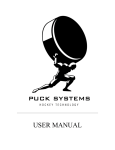
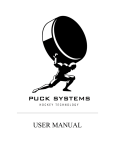
![Hockey Canada Registry User Manual [Complete]](http://vs1.manualzilla.com/store/data/006861334_1-f3aefff99f86c1666505c30ddd463ccc-150x150.png)
